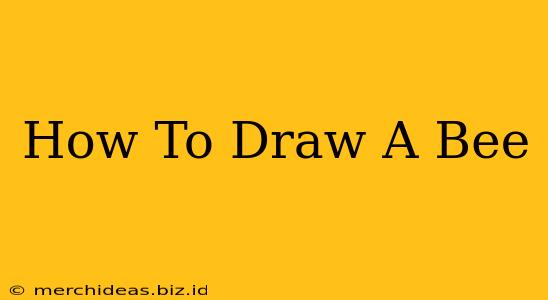So you want to learn how to draw a bee? Whether you're a seasoned artist or just starting out, this step-by-step guide will help you create a buzzing masterpiece! We'll cover everything from basic shapes to adding intricate details, making it easy for anyone to achieve a realistic or stylized bee drawing. Let's get started!
Getting Started: Materials You'll Need
Before you dive into drawing your bee, gather these essential materials:
- Paper: Use any kind of paper you prefer – sketch paper, drawing paper, even the back of an old envelope will do!
- Pencil: A regular HB pencil is perfect for sketching. A softer pencil (like a 2B) can be used for shading later.
- Eraser: A good eraser is crucial for correcting mistakes.
- Sharpener: Keep your pencil sharp for precise lines.
- Colored pencils, markers, or paints (optional): Add color to bring your bee to life!
Step-by-Step Bee Drawing Tutorial
Step 1: The Body Shape
Begin by drawing a slightly elongated oval for the bee's main body. This oval will be a bit thicker in the middle and taper slightly towards the ends. This forms the foundation of your bee.
Step 2: The Head
Add a smaller circle or semi-circle slightly overlapping the top left of the main body oval. This will be the bee's head.
Step 3: The Wings
Draw two pairs of wings. Each wing can be represented by a slightly curved teardrop shape. Position these wings symmetrically on either side of the bee's body. Remember that the top pair of wings is usually slightly larger than the bottom pair.
Step 4: The Legs
Add six legs extending from the bottom of the main body. Each leg can be a simple, slightly curved line. Try to keep them evenly spaced.
Step 5: The Antennae
Draw two short, straight lines extending from the top of the bee's head. These are the antennae. You can add a slight curve to the ends for a more realistic look.
Step 6: The Stripes
Now for the iconic bee stripes! Draw several horizontal stripes across the bee's body. These stripes should alternate between yellow (or a light color) and black (or a dark color). Feel free to vary the width of the stripes for a more natural look.
Step 7: The Eyes
Draw two small circles on either side of the head. These are the bee's eyes. You can add a small dot inside each circle to give them more depth.
Step 8: Refining Details and Shading
Once you're happy with the basic shapes, refine your bee drawing. Adjust lines, erase any unnecessary marks, and add more details. You can add tiny hairs around the body, more definition to the legs, or even some pollen on the legs. Consider adding shading to give your bee a three-dimensional appearance. Darken areas where shadows would naturally fall, such as under the wings or body.
Adding Color (Optional)
Once you’ve completed your pencil sketch, you can bring your bee to life with color! Colored pencils, markers, or paints can be used to create a vibrant and realistic bee. Remember to use appropriate colors—yellow, black, and brown are classic bee colors, but don’t be afraid to experiment!
Tips for Drawing a Realistic Bee
- Observe real bees: Spend some time observing real bees (from a safe distance, of course!) to understand their shape, proportions, and movement. Photographs are also a great resource.
- Use light sources: Consider how light interacts with the bee's body when you add shading.
- Practice: Drawing takes practice. Don't be discouraged if your first attempt isn't perfect. Keep practicing, and you'll improve over time.
By following these steps and practicing regularly, you'll be drawing amazing bees in no time. Happy drawing!
